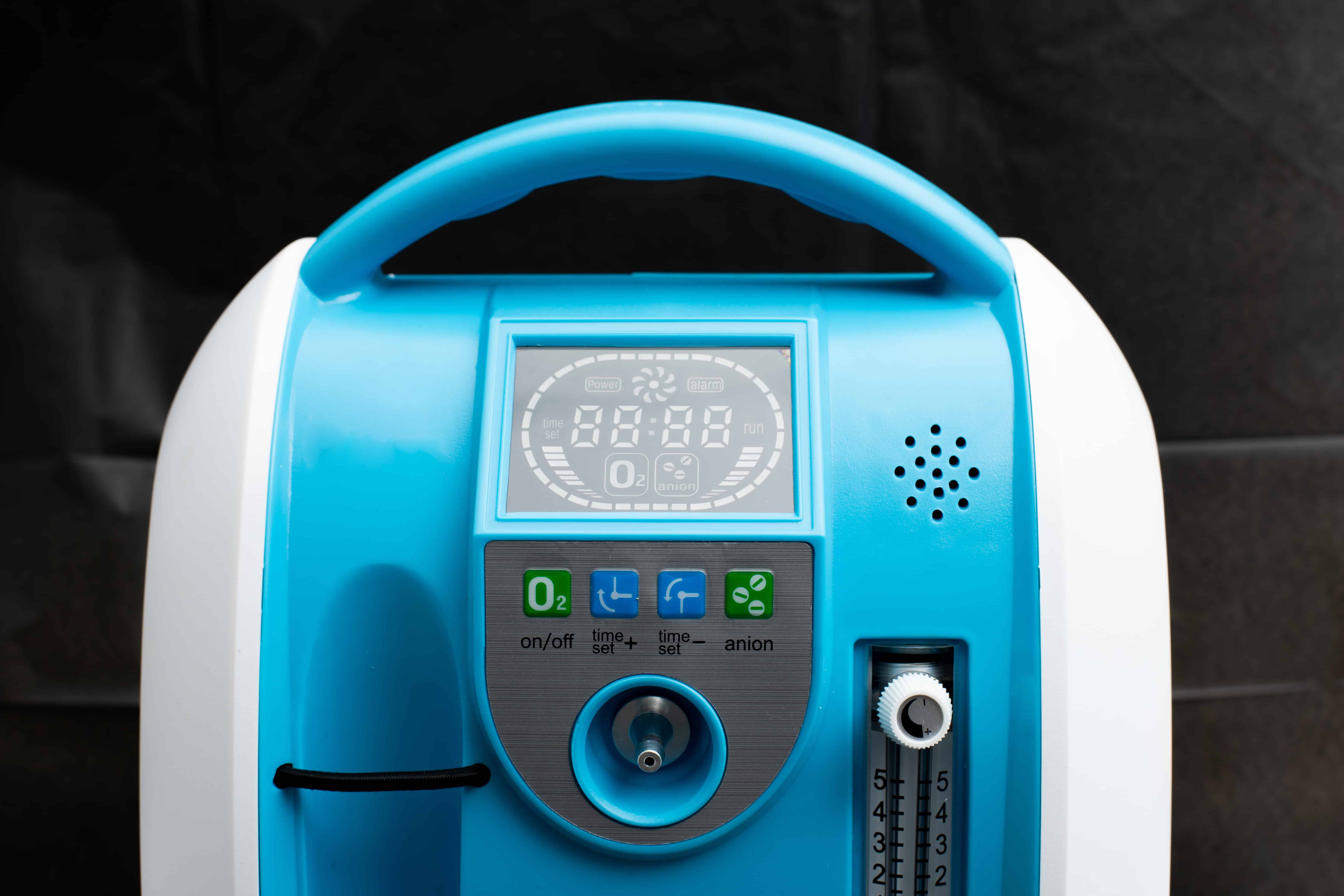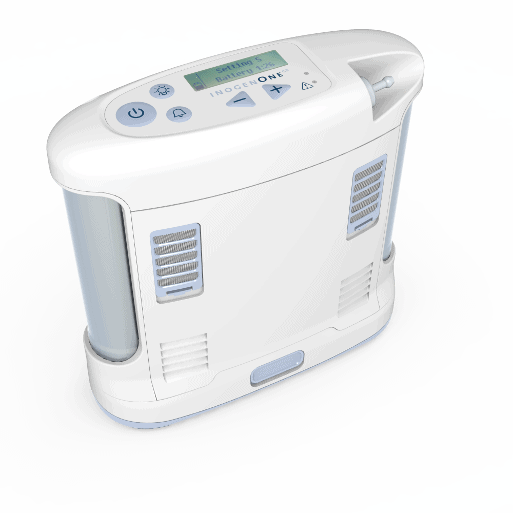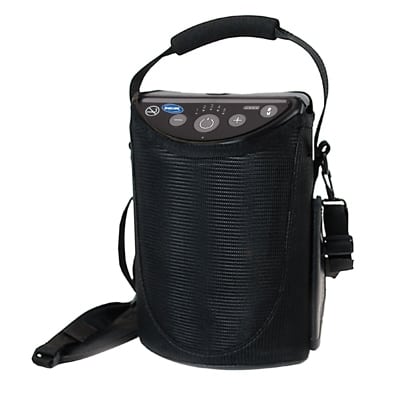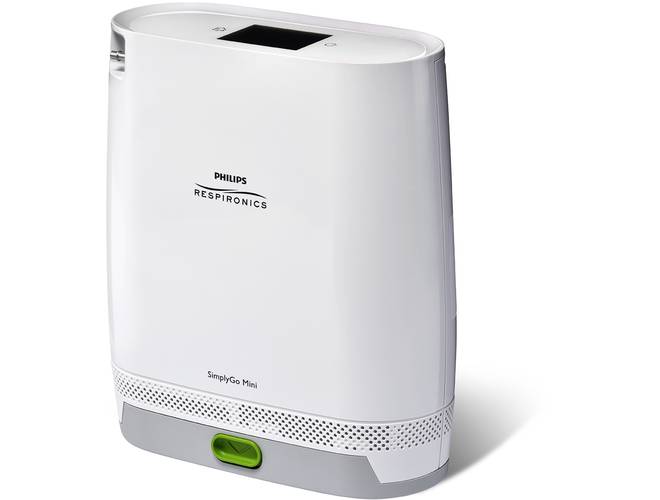Tip: Continuous flow units are the only option for those with sleep apnea because they work with BiPAP machines
Join for Free
Members get updates like best products for seniors and senior discounts delivered right to their inbox for free.

If your doctor has prescribed oxygen therapy, you might be wondering how to find a portable oxygen concentrator that fits your needs. Portable oxygen concentrators treat symptoms and provide peace of mind to those with breathing disorders.
While portable oxygen concentrators improve quality of life and provide greater independence, they also come at a cost. The process of choosing and purchasing a portable oxygen concentrator does not have to be complicated, though. This guide will help you navigate the ins and outs of portable oxygen concentrators, including brands, types, and pricing.
A portable oxygen concentrator is a compact device that efficiently and safely delivers oxygen to people who have trouble breathing or otherwise have low oxygen levels in their blood. The device works by filtering air, compressing it, and removing the nitrogen so that the oxygen concentration is higher. It then delivers that concentrated air continuously into the patient through a nasal cannula or specialized mask. The oxygen delivered through concentrators is typically around 95 percent of the air. For reference, 21 percent of the air we breathe every day is composed of oxygen.
These user-friendly machines were developed in the 1970s and improved upon in the subsequent decades to be safe, efficient, and lightweight. Portable oxygen concentrators differ from standard oxygen tanks in that they pull in outside air, so they do not have to be periodically refilled. The devices are small (typically 5 – 10 lbs, including the rechargeable battery), and they may be carried from room to room or taken out in public. Portable oxygen concentrators can be taken on the go, and the FAA approves most for air travel.
There are two different types of oxygen concentrators: portable and stationary. Stationary oxygen containers are powered by a wall outlet and are typically heavy, weighing in excess of 50 lbs. Stationary devices are designed for home usage, though they can be wheeled from room to room. These concentrators offer continuous oxygen flow, meaning the unit delivers oxygen at a steady rate (such as 1 liter per minute) when the device is in use. Stationary oxygen concentrators tend to cost less and are great for those who do not leave the house often or need the device when they are sleeping.
Tip: Continuous flow units are the only option for those with sleep apnea because they work with BiPAP machines
Portable oxygen concentrators are powered by pulse dose technology. Instead of providing continuous oxygen flow, these devices deliver oxygen based on your breath—the machine senses when you inhale and releases oxygen accordingly. Pulse dose technology is typically more sophisticated and allows users to view oxygen metrics and adjust the flow as needed. Some devices even connect to the Internet and allow for device troubleshooting or telehealth monitoring if the device malfunctions.
The greatest advantage that pulse dose technology offers is that the hardware is smaller, so users may take their oxygen concentrator with them. Some continuous oxygen concentrators are portable, but they are typically bulkier and have a shorter battery life than pulse dose concentrators.
Since these machines must be obtained with a prescription, you must talk with your doctor about what kind of oxygen concentrator is right for you. Oxygen administration is based on your symptoms. Receiving too little or too much oxygen can lead to major health complications, so it’s important to choose an oxygen concentrator that best suits your needs.
Oxygen concentrators are typically required for conditions that restrict the lungs from absorbing enough oxygen. Asthma affects 334 million people, and 65 million people suffer from Chronic Obstructive Pulmonary Disease (COPD), which account for substantial oxygen concentrator usage globally. Some heart conditions that cause low levels of oxygen in the blood also require oxygen concentrators.
Some may need oxygen concentrators for long-term continuous use. Some may need it only for sleeping. Others may only need concentrators for a short period to recover from surgery or treat temporary flare-ups for a chronic health condition.
Conditions that require oxygen concentrators include:
Your doctor will let you know what kind of oxygen therapy you need based on your condition and symptoms. Your doctor will give you a figure of liters per minute (LPM) of oxygen required. Portable units often let you adjust this number, but some stationary units may not. Keep your doctor’s instructions in mind when shopping for a concentrator.
There are various portable oxygen concentrators on the market. While your doctor will prescribe the settings and type of portable oxygen concentrator you will need to purchase, you can still shop around for a device that fits your lifestyle and budget.
I recommend Pure Medical to browse for quality portable oxygen concentrators. They offer models from Invacare, Inogen, and Philips, and their website lays out device specs and details in an easy-to-read and accessible format.

In the oxygen concentrator business since 2001, Inogen has a great deal of experience in oxygen therapy. The company strives to create highly portable devices to offer users more freedom. Inogen provides a variety of quiet, lightweight, portable oxygen concentrators that fits most people’s needs. For a more detailed look at these devices, check out my full Inogen oxygen concentrator review.
| Name | Specifications & Features | Price |
|---|---|---|
| Inogen One G3 | 4.8 lbs
Five oxygen settings via pulse dose delivery system FAA approved 4-hour battery life for single battery, 8 hours for double battery Single battery, carrying case, AC adapter, and DC power cable for car changing included 3-year warranty Inogen Connect app functionality to monitor oxygen levels |
From $2,295 |
| Inogen One G4 | 2.8 lbs
Three oxygen settings via pulse dose delivery system FAA approved 2.7-hour battery life for single battery, 5 hours for double battery Single battery, carrying case, carry strap, AC adapter, and DC power cable for car changing included 3-year warranty Inogen Connect app functionality to monitor oxygen levels |
From $2,295 |
| Inogen One G5 | 4.7 lbs
Six oxygen settings via pulse dose delivery system FAA approved 6.5-hour battery life for single battery, 13 hours for double battery Single battery, carrying case, AC adapter, and DC power cable for car changing included 3-year warranty Inogen Connect app functionality to monitor oxygen levels |
From $2,445 |

Invacare manufactures cost-effective and user-friendly medical devices to promote healthy, active lifestyles. What I like most about these devices is that they have an easy-to-read interface. The Platinum device is also water-resistant, so you don’t have to worry about being stuck in the rain with it.
| Name | Specifications & Features | Price |
|---|---|---|
| Invacare Platinum Mobile Oxygen Concentrator | 5 lbs.
Six oxygen settings via pulse dose delivery system Oxygen purity from 87% to 95.6% FAA approved Up to 3.5 hours of battery life 4-hour battery recharge time Single battery, carrying case, AC adapter, and DC power cable for car changing included Batteries can be swapped without turning off the unit Water-resistant 5-year warranty |
From $2,495 |
| Invacare XP02 | 6.4 lbs.
Five oxygen settings via pulse dose delivery system Oxygen purity from 87% to 95.6% FAA approved 5-hour battery life for single battery, 10 hours for double battery 2.5-hour battery recharge time Single battery, carrying case, AC adapter, and DC power cable for car changing included Batteries can be swapped without turning off the unit Water-resistant 5-year warranty |
From $3,148 |

Philips offers two portable oxygen concentrator devices. The larger SimplyGo option is useful because it has continuous flow and pulse dose functionality to deliver oxygen. The unit also comes with a two-wheeled cart for added portability. The “mini” version of the SimplyGo device only uses pulse dose technology, but it’s much lighter at 6 lbs with a battery installed.
| Name | Specifications & Features | Price |
|---|---|---|
| SimplyGo Portable Oxygen Concentrator Device | 10 lbs.
Both continuous flow up to 2 LPM and six setting pulse dose functionality Oxygen purity from 87% to 96% FAA approved 7-hour battery life for pulse setting and up to 3.5-hour battery life for continuous setting 2.5-hour battery recharge time Single battery, carry case, two-wheeled mobile cart, AC adapter, and DC power cable for car changing included Built-in alarms for technical fault, low battery, low oxygen purity, and high breath rate 2-year standard warranty with an optional extension for purchase |
From $1,999 |
| Philips Respironics SimplyGo Mini Portable Oxygen Concentrator | 6 lbs.
Five pulse flow oxygen settings Oxygen purity from 87% to 96% FAA approved Up to 9 hours with pulse setting Built-in “low O2” monitor and alarm Single battery, carry case, AC adapter, and DC power cable for car changing included 3-year standard warranty with an optional extension for purchase |
From $2,395 |
No matter what oxygen concentrator you choose, a new model is a pricey investment upwards of $2,000. There are a few factors to keep in mind before pulling the trigger on a portable oxygen concentrator, including your specific condition and your health insurance coverage.
While oxygen concentrators typically last five years, most people only use one for 1 to 3 years. The level of usage is something to keep in mind when investing in a portable oxygen concentrator. Some conditions require 24-hour usage, while other conditions only require oxygen usage during flare-ups.
If you know you will get a lot of use out of your portable oxygen concentrator over a long period of time, it’s worth purchasing one. If budget is a concern, most companies offer payment plans for oxygen concentrators so you can spread the cost of a device over some time. You may also purchase a used or refurbished portable oxygen concentrator for less than the cost of a new one, but these may have more problems than a brand new one due to wear-and-tear.
Renting a portable oxygen concentrator is another option for people. There are both short and long term rental options available. The Oxygen Concentrator Store offers weekly packages starting at $210 and daily packages that start at $35 per day. This is a great option for those who mostly use stationary oxygen concentrators but must travel for work or pleasure. The machine arrives 24 hours before your travel date and comes with extra batteries or other accessories you may need for your trip.
Longer-term rental options are also available. Depending on your insurance, renting a portable oxygen concentrator can come at little or no additional cost to you. Once you choose an oxygen concentrator brand, you can often arrange rentals through the manufacturer. The company will then coordinate with Medicare or your insurance company to determine eligibility. Some rental devices are available without insurance, but they can range from $200 to $5,000 per month, so make sure to read the fine print on any rental contract.
When calculating the cost of a portable oxygen concentrator, remember to factor in ongoing expenses as well. In most cases, you’ll need to buy replacement batteries, and the nasal cannula also needs regular replacement. Additionally, keep spare cannulas and batteries just in case.
Tip: Some rental portable oxygen concentrators are used or refurbished, so they may encounter more problems due to wear-and-tear than a brand new model.
Portable oxygen concentrators can be expensive, and if you need one, they’re often a necessity, not a luxury. The first step is to be sure you know exactly what your oxygen needs are and that you have a note from your doctor explaining those needs.
Once that’s established, decide what option fits your budget. Depending on your needs, you may want to rent or buy an oxygen concentrator. Luckily, there are many options available, so you should be able to find your preferred device. Don’t be afraid to shop around and ask lots of questions before committing to a purchase.
Yes, your doctor will need to provide a prescription with the kind of oxygen you require for your condition. The prescription will have information about the liters per minute (LPM) of oxygen required or whether you need a continuous or pulse dose device.
Most devices are FAA approved but always make sure with the manufacturer before you board a plane.
Some insurance, including Medicare, do cover rental portable oxygen concentrators. Often the manufacturer will help you navigate coverage.
You should purchase a portable oxygen concentrator if you know you will need it for six months or more. That being said: always consult with your doctor on the right option for you.
Depending on the brand, you may be able to purchase your rental device at some point during the contract by contacting the manufacturer.